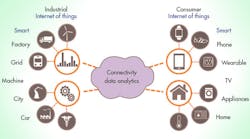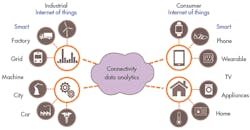We all have an aspect of our job that’s the most enjoyable. For me, it’s hearing how our customers and partners are solving today’s—and increasingly tomorrow’s—engineering challenges. Each year, in preparation for my keynote at our annual user conference (NIWeek), I work with leaders from some of our top customers who join me on the keynote stage to share their experience. This year was no exception.
As I and the more than 3200 attendees in the convention center heard from ADI, Airbus, Continental, GE, Intel, and others, it was clear that the convergence of business analytics, the social Web, the Internet of Things (IoT), and the Internet of Services is not a “future state.” It’s happening now in what is being called the fourth industrial revolution, or the “Industrial Internet” according to Dr. Joe Salvo, director of GE Global Research, founder and director of the Industrial Internet Consortium, and one of our featured keynote speakers.
It’s probably no surprise that the IoT was a key theme at NIWeek. Engineers involved in automated test, data acquisition, and industrial control understand it as a trend that has been decades in the making. The dialogue this year, however, revolved around the distinction between the consumer IoT and the industrial IoT, as well as the connectivity and data analytics platforms needed at the convergence of both.
As you can see from the figure, the consumer IoT refers to everyday items often associated with the IoT, such as smartphones and tablets, wearables, and home automation. In my previous article, I discussed the challenges involved in testing these types of devices and the need for test platforms that can adapt quickly to new technologies, such as the inclusion of wireless technology in devices that traditionally weren’t connected.
This file type includes high resolution graphics and schematics when applicable.
The Industrial IoT refers to the integration of more complex devices, machinery, and systems with networked sensors and software. You probably don’t ordinarily think of a car, train, or wind turbine as a “thing.” Yet, the ability to connect such systems for shared data collection and decision making will significantly impact business. For example, embedded technology connected into freightliners can optimize routes and save fuel and delivery cost, or alert engineers to potential mechanical breakdowns of wind turbines or other heavy machinery, saving millions of dollars, hours of time, or perhaps even lives.
On the NIWeek keynote stage, leaders from Airbus shared how they are applying the Industrial IoT through an initiative to reinvent aeronautic manufacturing called “Factory of the Future.” As you’d expect, aircraft manufacturers have very demanding manufacturing requirements. Production requires the assembly of large, heavy equipment; fabrication of complex electronic components; and precise mechanical alignment. Millions of people every year trust aircrafts to safely transport them around the world, so quality assurance with traceability is critical. The Factory of the Future is a research and technology project aimed to employ emerging computing and communications technologies to build an aircraft faster, more flexibly, and with high levels of quality. The steps Airbus took to solve that challenge are a lesson for us all.
To achieve its vision, Airbus’ engineering design team identified cyber-physical systems and data analytics as two essential technology elements. They devised a platform-based approach that would allow the reuse of investments across multiple areas. For example, they wanted the same code running on smart production tools, communication systems, and intelligent wearable devices to run on the company’s advanced robotic systems and mobility platforms.
Initially, Airbus attempted to solve each problem in isolation. One project team would build a smart tool while another would create a more efficient way to enter electronic records. The company soon discovered that inter-system communication and code reuse was very difficult and too time-consuming for its small team of engineers. So a platform-based approach was decided on, which included creating a software framework that could be applied across a common set of hardware targets. Building upon this framework, Airbus was able to invest in creating better core algorithms for critical functions such as vision, filter design, and motion planning.
How does this look in practice? Well, let’s just say the company’s future involves shades. During the keynote, Airbus demonstrated prototype wearable intelligent eyeglasses for aircraft assembly. On the A350 subassembly, roughly 400,000 locations need to be drilled, inspected, and tightened during production. The camera in the glasses uses edge detection of the holes and provides relevant information as one navigates through the panel. The operator sees a display of the panel with graphics indicating bolts to tighten and the appropriate tool to use. The smart tool automatically controls the torque for assembly and logs the results to Airbus’ quality-assurance database, all in real time.
But, Factory of the Future doesn’t stop at smart tools. Airbus also developed what they call the Open Robot Interface. Its manufacturing operations use industrial robots from companies like ABB, Fanuc, and KUKA. They want these robots to integrate with smart tools and devices and for the robotics application software to scale across all systems. To do this, existing industrial machine controllers are being augmented with the same platform used in its smart tool prototypes.
The result? A 10X reduction in development time over previous approaches. Using a platform-based approach, the Airbus team is reusing existing IP and leveraging code from the Linux community, robot vendors, and its other Factory of the Future designs. In summary, it’s simply more productive, and as a result, makes significant progress on its vision.
But, don’t take my word for it. Watch the videos at http://www.ni.com/niweek/keynote-videos/ and hear for yourself how leading engineering organizations use platform-based architectures to both test and design the multi-dimensional IoT. (Find the Airbus video segment on Aug. 6 under “Factory of the Future” and Dr. Salvo on Aug. 7 under “Engineering experts panel.”)
Are you ready? Your devices and machines await.


